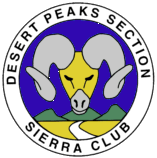Pat Keyes Canyon29-May-92By: Steve Smith |
 |
|
| As part of the 4th annual California State Trails Week program, I scheduled a BLM volunteer project to do trail work in Pat Keyes Canyon. Pat Keyes Canyon is a major canyon on the east side of the Inyo Mountains which leaves the Inyo crest about two miles north of Mt. Inyo. Pat Keyes canyon is at the northern end of the BLM proposed Inyo Wilderness Area. To the south are McElvoy, Keynot and Beveridge canyons while to the north is one prominent unnamed canyon which is unofficially becoming known as Cougar canyon. This name reportedly comes from when Bureau of Mines personnel heard cougar in the canyon while doing a minerals survey for the wilderness evaluation report. From its top along the Inyo crest at 11,000', Pat Keyes drops steeply down to 1,600' where the canyon mouth opens into Saline Valley. A look at the 7.5 Pat Keyes Canyon topographic map shows this drops occurs in about 10 linear miles - it also shows eight "Falls" Since I had never heard of anyone ever descending the length of the canyon, I had no information on what we might encounter or what was necessary to make the descent. So we took plenty of rappel gear and eight ropes. Our project involved trail work and resource inventory. We planned to map and initiate signing the route of the Pat Keyes trail. This trail extends east from the Inyo crest and drops down to a mill site ruins at 7,000' in the bottom of Pat Keyes canyon. From the ruins we would then descend down the canyon bottom to document resource values, historic features, use conditions and any other information which would be of value for managing this area under interim management as a wilderness study area or as a wilderness if it is designated by Congress. With eight "Friends of the Inyo WSA" and Desert Survivor volunteers, we left Pat Keyes Pass early Thursday afternoon. A fairly good trail extends out on the Pat Keyes/Cougar ridge for about two miles before turning southwest and switch-backing another two miles down to the ruins. Sections of the trail were hard to find and we placed several brown carsonite trail markers to help show the alignment where it was wasn't obvious. Out on the ridge, the trail passed an old cabin site where numerous artifacts were seen. On the way down, we could see where the trail climbed up the south side of the canyon from Pat Keyes spring and headed towards McElvoy Canyon. In a subsequent trip, two of the volunteers hiked in again and followed that trail to map it out. It went up on the Pat Keyes/McElvoy ridge and then dropped down and intersected the McElvoy Canyon trail at another mill site ruin at 5,200' in McElvoy Canyon. We reached the Pat Keyes mill site by early evening and enthusiastically recorded the various historic mining artifacts and rock walled remains of a cabin. A large intact arrastre with gas powered engine which had a 1892 patent date was a notable feature. Next morning the going was slow down canyon as we continually fought through heavy brush. Surface water was flowing most of the way and by mid-afternoon we were down to 5,280' when we encountered two 120' waterfalls. By the time everyone had rappelled down them, it was getting dark so we used a few small level spots for Friday nights camp. Saturday was more of the same - more brush and eight waterfalls up to 100' high. Seven of the waterfalls we had to rappel to get down and the eight was an easy climb around. Two were particularly interesting. At 3,300' was rappel No. 6 - So' high, covered with aquatic foliage which we named "Sweet Misty" since it had a spray of water hitting us during the rappel. At 3,100' was rappel No. 7 - 100' high which dropped into a huge water eroded basin which I named "Chasm 2" since it was similar to the No. 8 rappel in Keynot canyon which we had named "Chasm" Since flat room was limited, we camped in two groups above and below rappel No. 11 at 2,400' Saturday night. Sunday went fast with only a mile to cover but four more waterfalls requiring three rappels. Rappel No. 11 at 1,900' was quite impressive. A 200' long rock ledge extended out into the center of the canyon with two deeply entrenched waterfalls of both sides - we named it "The Tongue" and did a 80' rappel off the tip of the tongue. The last rappel was just inside the canyon entrance - 80' and then just a couple of minutes walk to the roadhead at 1,600'. There was a good surface water flow through about 75% of the canyon which adds to the aesthetics of having water flowing each of the waterfalls. While the water flow will lessen during the summer and fall, it appeared lush enough to provide a year round flow for hikers to use. The only previous evidence of descending the canyon was some pieces of climbing gear at the first and last waterfalls but nothing at the other 10 rappel points in between. Pat Keyes is the longest canyon and requires the most time to descend of any of the eastern side Inyo canyons due to its length, fairly heavy and lengthy brush segments and 12 rappels. As with all the other east side Inyo canyons, Pat Keyes is extremely rugged, scenic and provides a memorable canyon experience. | ||
| DPS Archives Index | Desert Peaks Section | ||